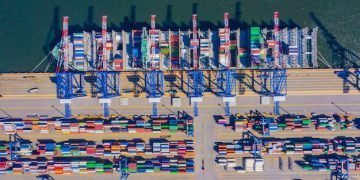New Infrastructure Bill: Impact on US Transportation

The New Infrastructure Bill, officially known as the Infrastructure Investment and Jobs Act, is set to allocate billions of dollars to revamp and modernize transportation systems across the United States, impacting roads, bridges, public transit, and more.
The New Infrastructure Bill: How Will it Impact Transportation Across the US? has finally arrived, promising a major overhaul of the nation’s infrastructure. But what exactly does this mean for how we move around and how goods are transported?
Understanding the Scope of the New Infrastructure Bill
The Infrastructure Investment and Jobs Act, signed into law, represents a historic investment in America’s infrastructure. Understanding its scope is crucial to grasping its potential impact. This bill encompasses a wide array of projects aimed at modernizing and improving various aspects of transportation.
Key Areas of Investment
The bill allocates significant funding to different sectors within transportation. It’s not just about repairing roads; it’s a comprehensive effort to upgrade infrastructure across the board.
- Roads and Bridges: A substantial portion is dedicated to repairing and rebuilding existing roads and bridges, ensuring safer and more efficient travel.
- Public Transit: Investments in public transportation systems aim to expand services, improve accessibility, and reduce commute times.
- Rail: Funding is allocated to modernize and expand rail networks, including passenger and freight rail, to enhance connectivity and efficiency.
- Airports: Improvements to airport infrastructure will help enhance safety, reduce congestion, and support increased air travel.
These investments are not just about fixing what’s broken; they’re about building a more resilient and sustainable transportation system for the future.

In conclusion, the New Infrastructure Bill’s scope is broad and ambitious, targeting critical areas of transportation to create a more efficient, safe, and sustainable system.
Roads and Bridges: A Much-Needed Overhaul
One of the most visible impacts of the Infrastructure Bill will be on roads and bridges. Decades of underinvestment have left many of these vital arteries in disrepair. This section explores how the bill aims to address these critical needs.
Addressing the Infrastructure Deficit
The bill provides significant funding to address the backlog of road and bridge repairs. This includes not only fixing existing structures but also modernizing them to meet current and future demands.
Modernizing roads and bridges is crucial for ensuring efficient transportation and reducing the risk of accidents.
Technological Advancements
Beyond basic repairs, the bill promotes the integration of new technologies into road and bridge infrastructure. These advancements can enhance safety, reduce congestion, and improve overall efficiency.
- Smart Traffic Management Systems: Implementing systems that use real-time data to optimize traffic flow and reduce congestion.
- Advanced Materials: Utilizing durable and sustainable materials to extend the lifespan of roads and bridges.
- Connected Vehicle Technology: Integrating technology that allows vehicles to communicate with each other and infrastructure, enhancing safety and efficiency.
These technological improvements are essential for creating a modern transportation network that can meet the challenges of the 21st century.
In summary, the focus on roads and bridges in the New Infrastructure Bill represents a crucial step towards revitalizing America’s transportation network. This will not only improve safety and efficiency but also pave the way for future technological advancements.
Revitalizing Public Transportation
Public transportation is a vital component of any modern society, providing affordable and sustainable mobility options. The Infrastructure Bill includes substantial investments to revitalize and expand public transit systems across the country. This section examines how these investments will transform public transportation.
Modernizing Transit Systems
The bill allocates funds to modernize existing transit systems, including buses, trains, and subways. These improvements aim to enhance reliability, accessibility, and overall rider experience.
Modernization includes upgrading outdated equipment, improving safety measures, and enhancing accessibility for individuals with disabilities.
Expanding Access to Public Transit
The bill also focuses on expanding access to public transit in underserved communities. This includes extending transit lines, increasing service frequency, and improving connectivity to other modes of transportation.
- Extending Transit Coverage: Expanding transit routes to reach more communities and employment centers.
- Increasing Service Frequency: Providing more frequent service to reduce wait times and improve convenience.
- Improving Connectivity: Creating seamless connections between different modes of transportation, such as buses, trains, and bike-sharing programs.

By expanding access to public transit, the bill aims to reduce traffic congestion, improve air quality, and provide affordable transportation options for all.
To conclude, the investments in public transportation within the New Infrastructure Bill are poised to transform how Americans move within cities and regions. These improvements will create more efficient, sustainable, and equitable transportation options for communities across the nation.
The Future of Rail Transportation
Rail transportation is experiencing a resurgence in popularity, driven by its efficiency, sustainability, and potential to reduce congestion. The Infrastructure Bill aims to capitalize on this momentum by investing in both passenger and freight rail systems. This section explores how these investments will shape the future of rail transportation in the US.
Enhancing Passenger Rail
The bill allocates significant funding to enhance passenger rail services, including Amtrak. These investments aim to improve speed, reliability, and frequency of passenger trains.
Improvements to passenger rail can reduce travel times, connect communities, and provide an alternative to driving or flying.
Modernizing Freight Rail
In addition to passenger rail, the bill also supports improvements to freight rail infrastructure. Modernizing freight rail can improve efficiency, reduce transportation costs, and alleviate pressure on highways.
- Upgrading Rail Lines: Improving the condition of rail lines to support heavier loads and faster speeds.
- Expanding Rail Capacity: Adding new tracks and sidings to increase the capacity of the rail network.
- Improving Intermodal Connections: Enhancing connections between rail and other modes of transportation, such as trucks and ships.
These upgrades will allow freight rail to handle more goods, reduce congestion on highways, and lower emissions from transportation.
In conclusion, the focus on rail transportation in the New Infrastructure Bill represents a strategic investment in a sustainable and efficient mode of transportation. These improvements will benefit both passengers and freight shippers, contributing to a more connected and competitive economy.
Airports: Upgrading for the 21st Century
Airports serve as critical gateways for both passengers and cargo, connecting communities to the global economy. The Infrastructure Bill includes provisions to modernize and enhance airport infrastructure across the country. This section examines how these investments will prepare airports for the demands of the 21st century.
Improving Airport Capacity
The bill provides funding to increase airport capacity, including expanding runways, terminals, and other facilities. These improvements will help reduce congestion, improve on-time performance, and accommodate future growth in air travel.
Expanding airport capacity is crucial for supporting increased air travel and promoting economic development.
Enhancing Safety and Security
In addition to capacity improvements, the bill also focuses on enhancing safety and security at airports. This includes upgrading security screening equipment, improving air traffic control systems, and enhancing cybersecurity measures.
- Upgrading Security Screening: Deploying advanced screening technology to detect threats more effectively.
- Improving Air Traffic Control: Modernizing air traffic control systems to enhance safety and efficiency.
- Enhancing Cybersecurity: Protecting airport systems from cyberattacks that could disrupt operations.
These enhancements will help ensure the safety and security of passengers and cargo traveling through airports.
In summary, the investments in airport infrastructure in the New Infrastructure Bill are vital for maintaining America’s competitiveness in the global economy. These improvements will enhance safety, reduce congestion, and prepare airports for future growth in air travel.
Funding and Implementation: A Closer Look
The New Infrastructure Bill is not just about vision; it’s about execution. This section delves into the crucial aspects of funding and implementation, examining how the allocated funds will be distributed and managed to ensure projects are completed efficiently and effectively.
How Funds Will Be Distributed
The bill outlines specific formulas and processes for distributing funds to state and local governments, as well as federal agencies. Understanding these mechanisms is essential for stakeholders at all levels.
Understanding the distribution mechanisms is crucial for states and local governments to access the funds they need for infrastructure projects.
Ensuring Effective Implementation
To maximize the impact of the bill, it is essential to have effective oversight and accountability mechanisms in place. This includes monitoring project progress, ensuring compliance with regulations, and preventing waste and fraud.
- Project Monitoring: Tracking the progress of infrastructure projects to ensure they are on schedule and within budget.
- Regulatory Compliance: Ensuring that projects comply with environmental regulations and other legal requirements.
- Preventing Waste and Fraud: Implementing measures to prevent waste, fraud, and abuse in infrastructure spending.
Effective implementation is key to ensuring that the New Infrastructure Bill delivers its intended benefits to communities across the country.
In conclusion, the success of the New Infrastructure Bill hinges on effective funding and implementation. By understanding how funds will be distributed and ensuring proper oversight and accountability, stakeholders can maximize the impact of this historic investment in America’s infrastructure.
| Key Point | Brief Description |
|---|---|
| 🛣️ Road & Bridge Repair | Bill allocates funds for repairing and upgrading roads and bridges nationwide. |
| 🚆 Public Transit | Investments aim to modernize and expand public transit systems for better accessibility. |
| ✈️ Airport Upgrades | Funding provided to enhance airport capacity, safety, and security measures. |
| ⚙️ Tech Integration | Incorporating smart systems and advanced materials for efficient transportation. |
Frequently Asked Questions
▼
The Infrastructure Investment and Jobs Act, also known as the New Infrastructure Bill, is a comprehensive piece of legislation that allocates funds to improve infrastructure across the United States.
▼
The bill provides substantial funding for repairing and rebuilding existing roads and bridges, as well as integrating advanced technologies to enhance safety and efficiency.
▼
Investments will modernize transit systems, expand access to public transit in underserved communities, and improve connectivity between different modes of transportation.
▼
The bill supports improvements to both passenger and freight rail systems, enhancing speed, reliability, and frequency of passenger trains, and modernizing freight rail infrastructure.
▼
The bill includes funding to increase airport capacity, enhance safety and security measures, and modernize air traffic control systems to support future growth.
Conclusion
The New Infrastructure Bill represents a monumental opportunity to modernize and improve transportation systems across the United States. From roads and bridges to public transit, rail, and airports, the investments outlined in the bill promise to create a more efficient, safe, and sustainable transportation network for generations to come.





